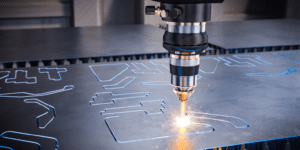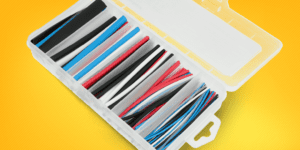Spis treści:
Have you ever wondered how 3D printing works or how you can use it today? If so, you’ve come to the right place:
- we’ll discuss the basics of 3D printing,
- we’ll show you what you can do with it,
- we’ll explain how this technology can speed up the realization of your projects.
3D printing is an innovative production technology. With a 3D printer you can create/build spatial material objects based on digital models. It prints them layer by layer according to a digital scheme. These devices became very popular in the first decade of the 21st century, when the first 3D printers for personal use came on the market.
Where did it come from?
Most people did not hear about 3D printing until the 21st century. However, the idea of creating physical constructions based on drawings was born in the 20th century. It was different from the 3D printing as we understand it today. The pattern was produced in a layer-by-layer fashion in liquid polymer, using a laser beam. Modern 3D printers usually use special filaments – mostly plastic fibers that are melted in the nozzle.
3D designs for printing – Digital files
Before you start printing, you need a 3D digital model of the object you want to create. You can design it in various 3D modeling programs (CAD – computer-aided design) or use a 3D scanner that scans the item you want to duplicate. Common 3D printing programs include Solidworks, Blender, Tinkercard, and many others. The digital file instructs the printer exactly how to create the 3D object by dividing it into layers and specifying the exact dimensions of each layer.
3D Printers – How do they work?
Once we have prepared a digital file, we need to send it to our 3D printer. But how does that work exactly? A 3D printer must accurately copy every layer described in the file, which means it needs a free and clean space large enough to print the object. That is why 3D printers are usually placed in containers or work chambers. These devices use very different technologies. They typically use nozzles or lasers to build objects layer-by-layer and then they stiffen the material. For this reason, 3D printers need to be carefully calibrated.
Types of 3D printing
3D printing technologies have been around for decades. But the real turning point came in 2009, when the type of 3D printing technology called FDM (fused deposition modeling) became available to the public after the patent expired. As a result, 3D printing became relatively inexpensive and very popular. Today, FDM is still the most widely used method of 3D printing. However, there are many other 3D printing technologies that are used in various fields of science.
What can you create with 3D printing? – Stuff from a 3D printer
It is difficult to find areas that have not been affected by 3D printing yet. Companies around the world use 3D printing techniques to solve their problems and improve the efficiency of production processes. This type of printing, when used in mass production, is cheaper than any other method. It’s also the fastest option when it comes to building prototypes.
- Custom Models: Create products that are tailored to your needs in size and shape. For example, some companies make 3D-printed shoes on order, so you can customize them as you wish.
- Rapid prototyping: 3D printing enables the rapid creation of a model or prototype, helping engineers, designers and companies visualize their projects and get feedback on their products in the shortest possible time.
- Lower costs: Thanks to the materials used, the cost of 3D printing and making 3D prototypes is relatively low. One model can be printed many times, so production time and waste are reduced.
- Mass production: With printers connected to a Wi-Fi network, you can create what is called a printer farm with several interconnected devices to print small elements in large numbers (or with a few 3D printers that print smaller elements of a larger project, which are then assembled into a complete object).





Previous
Next
Now, let’s see what you can create with a 3D printer nowadays. Discover the joys of digital production!
Recommended 3D Printers – 3D Printing Cost
Up to PLN 1,000
- Anet A8 – a printer that stands out for its low price. It has a printing volume of 220 x 220 x 240 mm. It supports the most popular filaments: ABS, PLA, etc. with a diameter of 1.75 mm. The printer requires self-assembly.
- Anet A6 – the bigger brother of the Anet A8 printer. Its printing volume is 220 x 220 x 250 mm. It supports the most popular filaments: ABS, PLA, etc. with a diameter of 1.75 mm. The set also requires self-assembly.

Up to PLN 2,000
- Creality Ender-3 – a popular printer for just about PLN 1000. Its printing volume is 220 x 220 x 250 mm. It uses the most popular filaments: PLA, TPU, etc. with a diameter of 1.75 mm. The printer can automatically resume printing after a power failure. The Ender-3 is also available in a Pro version which features improved printing stability, a magnetic printing surface and a stable power supply. Both versions of the printer consist of several components for self-assembly.
- Creality CR -20 – a printer capable of printing layers with a thickness of 0.05 mm (while the minimum thickness of layers in the Ender-3 printer starts at 0.1 mm). The printing volume is 220 x 220 x 250 mm. The CR -20 has a function to automatically resume printing. Just like Ender-3, the CR -20 is available in a Pro version with an improved printing interface. The set requires self-assembly.

Up to PLN 4,000
- Dobot Mooz -3 – a modular printer that can be converted into three constructions. The single-axis one is also the most effective, while the double-axis one is the most stable and precise. On the other hand, the Delta mode allows mixing different colors to create multicolored structures. The Mooz-3 printing volume is 130 x 130 x 130 mm. The set consists of several modules for self-assembly.
- Vertex Delta – a printer with a printhead that moves by means of magnets. The printing volume is 200 x 225 mm. The printer is a hybrid kit, it is delivered in several parts and requires self-assembly.
- Dobot Mooz-2 Full – a printer set consisting of three heads: printing, cutting (CNC) and laser. The printing volume is 130 x 130 x 130 mm. The set includes safety glasses and a protective shield box. The modules require self-assembly.
- Prusa MK3S – a popular printer from the renowned company Prusa Research. Designed for printing elements with maximum dimensions of 210 x 210 x 250 mm. It has a magnetic, removable heatbed and a stable frame. It is quiet and fast and equipped with a wide range of sensors. Are you wondering how to build a 3D printer? The Prusa set consists of elements for self-assembly, and its manufacturer provides comprehensive illustrated assembly instructions in several languages.

Up to PLN 8,000
- Zortrax M200 Plus – this popular Zortrax printer has a unique design and a touch screen. Thanks to a WiFi connection option you can use it in a printer farm. It also has a built-in camera which allows you to monitor the progress of your work constantly. The printing volume is 200 x 200 x 180 mm. The printer is factory-assembled.
- Zortrax Inkspire – a printer that offers a completely different type of printing. Instead of the standard materials (such as filaments), the printer uses liquid light-curing resin. This type of printer can be used for very precise and detailed projects. It is used e.g. in medicine and jewelry. The printing volume is 175 x 132 x 74 mm.
- Zortrax Inventure – uses the LPD Plus technology, which is characterized by two printheads that alternately dispense the printing material and the support material. The support material is water soluble. The printer has a sealed chamber with a HEPA filter. It uses smart cartridges. The printing volume is 135 x 135 x 130 mm.

What is needed for 3D printing? – 3D printing – materials (filaments)
A 3D printer alone is not enough to start printing – it’s the material you use that is essential. You need to choose a suitable filament for every project.
Our store offers filaments for 3D printing, including materials such as: PLA, PLA Pro, ABS, Smart ABS, PETG, Rubber, HIPS-X, as well as other, less popular ones.
How to choose the right filament? You can find the answer to this question in our guide on Filaments in 3D printing.
Hello! Tutorials and 3D printing are our passion! We can teach you and show you the latest news from the world of technology. Make sure that this area has no secrets for you.
- How can you use a 3D printer?
- Snapmaker and modular 3D structures
- Mayku Formbox – Create Your Own 3D Chocolates!
How useful was this post?
Click on a star to rate it!
Average rating 0 / 5. Vote count: 0
No votes so far! Be the first to rate this post.











